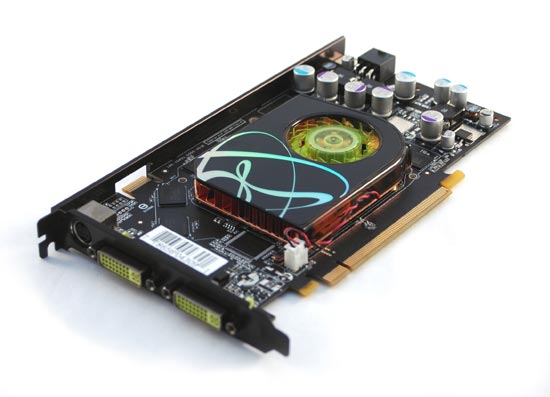The NVIDIA GeForce 7900 GS: A Closer Look
by Josh Venning on September 19, 2006 5:00 AM EST- Posted in
- GPUs
XFX
Finally, we also have a 7900 GS from XFX, the XFX GeForce 7900 GS RoHS Extreme.

This is the same XFX 7900 GS we looked at in the 7900 GS launch article, but we'll be delving a little deeper for this review.

This 7900 GS has a sleek black look that is a little different than the colorful light-colored XFX cards we've seen in the past. The design is the same as the reference card, aside from the noticeable bar along the top with the XFX logo on it. We aren't sure why they designed the card this way, but it gives the card a unique look that sets it apart from our other 7900 GS cards. The XFX 7900 GS RoHS Extreme comes with a somewhat modest factory overclock (in spite of the "Extreme" label) of 480MHz on the core and 700MHz on the memory.
There are also no games included in the bundle for this card and it lists for about $211 right now, which is slightly higher than the factory overclocked BFG 7900 GS. Out of the box, the BFG looks to be a better deal, but as we will see in the overclocking section, this card could come out ahead with user overclocking.
Finally, we also have a 7900 GS from XFX, the XFX GeForce 7900 GS RoHS Extreme.

This is the same XFX 7900 GS we looked at in the 7900 GS launch article, but we'll be delving a little deeper for this review.

This 7900 GS has a sleek black look that is a little different than the colorful light-colored XFX cards we've seen in the past. The design is the same as the reference card, aside from the noticeable bar along the top with the XFX logo on it. We aren't sure why they designed the card this way, but it gives the card a unique look that sets it apart from our other 7900 GS cards. The XFX 7900 GS RoHS Extreme comes with a somewhat modest factory overclock (in spite of the "Extreme" label) of 480MHz on the core and 700MHz on the memory.
There are also no games included in the bundle for this card and it lists for about $211 right now, which is slightly higher than the factory overclocked BFG 7900 GS. Out of the box, the BFG looks to be a better deal, but as we will see in the overclocking section, this card could come out ahead with user overclocking.










42 Comments
View All Comments
sum1 - Friday, September 22, 2006 - link
It’s listed at 540MHz everywhere else in this article (including the benchmarks).I posted this discrepancy twice, days ago, hasn’t anyone else noticed yet?
Josh Venning - Saturday, September 23, 2006 - link
It's been fixed. Thanks for pointing this out, and we apologize for not fixing it sooner.PerfectCr - Thursday, September 21, 2006 - link
Fan Noise? How do I know how loud/quiet the fans are? Do they throttle?kmmatney - Tuesday, September 19, 2006 - link
Its interesting how the XFX card (the only RoHS card - uses less lead and other hazardous chemicals) uses more power. I wonder if this will be true of other RoHS devices.yyrkoon - Wednesday, September 20, 2006 - link
I can tell you that the motherbord I use, which is also RoHS 'certified' (Asrock AM2NF4G-SATA2) runs pretty dahmed cool (sub 95F, when ambient is 80F ish), doesnt even use active cooling for the chipset etc either. Reguardless, if its the actual cause or not, I think its well worth it in the long run.Zaitsev - Tuesday, September 19, 2006 - link
On page 3 third line, "NVIDIDA intends for it to be a direct competitor to ATI's X1900 GT"Zaitsev - Tuesday, September 19, 2006 - link
Sorry, that should be page 2.Josh Venning - Tuesday, September 19, 2006 - link
fixed, thanksHoward - Tuesday, September 19, 2006 - link
I believe the bar is there to reduce PCB bending under weight.DerekWilson - Tuesday, September 19, 2006 - link
It's possible I suppose ... but it seems to me that you'd want to attatch the bar to the pcb at more than two points if this is the case. And you might also want to connect it to the slot cover for the added support of the case screw. Granted, I'm not a mechanical engineer, but it seems to me that connecting one part of the pcb to another like this would just move any moment created by the weight of the HSF somewhere else on the pcb.I've also never seen a graphics board bend under normal use. Intel motherboards are another story though. :-)
Whether or not its made for this, I do have a good use for it: having this bar makes it easier to find a place to grab when removing the card. Sometimes it's tough to find a spot on the pcb to grab, and sometimes the HSF solution isn't mounted in such a way that it's stable enough to use either (I distinctly remember the 6600 GT really disliking any contact with the HSF). This doesn't apply to the huge heat-sink-is-bigger-than-my-forearm solutions though -- they're usually bolted on pretty tight.